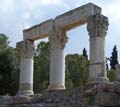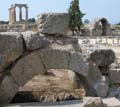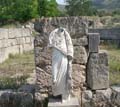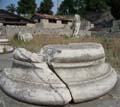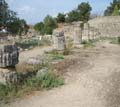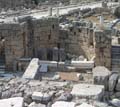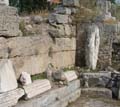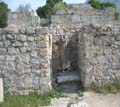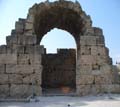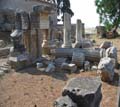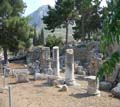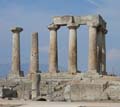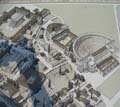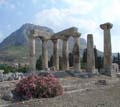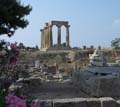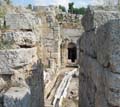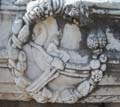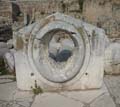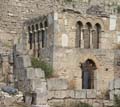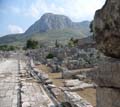
The economic and artistic prosperity of Corinth begins from the 8th century BC and is associated with the rule of the Bacchiades family and the establishment of two important colonies, Corfu and Syracuse. The development of the city peaks in the years of the Cypseleids (after the middle of the 7th century BC). In the 5th c. BC Corinth was one of the three greatest powers of Greece and took part in all the conflicts against the Persians. After the removal of the Persian danger, the intense competition with Athens brought Corinth to a secondary position. Important milestones in its history were its razing by the Romans in 146 BC. and its resettlement by Julius Caesar in 44 BC, which marked the beginning of a new period of prosperity for the city.
An important center since the earliest Neolithic era (6th millennium BC). The finds bear witness to intense commercial activities of the inhabitants with the Aegean and other regions. Few traces of the Mycenaean era. The great Greek city had two commercial ports, Lechaio on the Gulf of Corinth and Kenchrees on the Saronic, connected to each other by the cobbled causeway for the transport of ships and goods over land with wheels (a part of it survives today). Corinth flourished thanks to its developed trade and colonization between the 8th and 6th centuries. BC, while in the Hellenistic era it was the capital of the Achaean Commonwealth. It was destroyed in 146 BC. by the Romans and re-established in 44 BC. as a Roman colony.
From its fortified enclosure which included the particularly walled acropolis, Akrokorinthos, only certain parts are preserved. Formed archaeological site is the market with public buildings and traces of commercial activity. On a hill, the Doric temple of Apollo with 7 upright columns (6th century BC). Fountains were established in the place of natural springs: Glauki, the Holy spring and Pirini with monumental architectural configuration by Herodes Atticus in the middle of the 2nd century. A.D. The stadium was built in the market square. In Roman times, when Corinth was the capital of the Roman province of Greece, it had four basilicas (Roman courts), temples, a podium (rostrum) connected to the preaching of the apostle Paul around the middle of the 1st century. A.D. At that time, Lechaiou Street was formed paved, along which there are shops, public buildings, the Roman precinct of Apollo in the place of the archaic temple of the god and bath complexes in the E. The renewed in these times S. stoa also houses the Roman senate.
To the N. of the market is the conservatory with a peristyle courtyard, directly connected to the theater that was remodeled in Roman times. In the eastern part of the city are the remains of the Roman amphitheatre, the only one in mainland Greece, and in the north the ruins of the Asklepiion and the source of Lerna. In the foothills of Acrocorinthos, extensive ruins of the sanctuary of Demeter and Koris, in operation since the 7th c. BC until the 4th c. A.D. Important Archaeological Museum. In early Byzantine times, it was the capital of the province of Achaia and the seat of the Metropolitan of Greece. It is destroyed by earthquakes in 365 and 375 and by Alaric in 396, but is rebuilt. The new wall encloses only part of the original area of the city. On the W. side of the inner wall of Acrocorinthos, sections of masonry from the 6th - 7th c. Remains of a bath (5th c. ) and a building that preserves a mosaic floor with symbolic figures and the inscription "good times" (4th c.). Cemeteries of the early Christian period. At least four basilicas are known: 1. Basilica of the Skull, with an attached baptistery (around 500). 2. basilica of the martyr Kodratos, at the Kritika site (early 6th century). 3. basilica with baptistery in Scutela, NW. of ancient Corinth (early 6th century). 4. Basilica of Agios Leonides in Lechaio, 186 m long, three-aisled with a three-part transversal aisle (second half of the 5th century). In the same location, remains of port facilities and ruins of a large building, of unspecified use, with marble cladding on the walls and marble flooring. At least four basilicas are known: 1. Basilica of the Skull, with an attached baptistery (around 500). 2. basilica of the martyr Kodratos, at the Kritika site (early 6th century). 3. basilica with baptistery in Scutela, NW. of ancient Corinth (early 6th century). 4. Basilica of Agios Leonides in Lechaio, 186 m long, three-aisled with a three-part transversal aisle (second half of the 5th century). In the same location, remains of port facilities and ruins of a large building, of unspecified use, with marble cladding on the walls and marble flooring. At least four basilicas are known: 1. Basilica of the Skull, with an attached baptistery (around 500). 2. basilica of the martyr Kodratos, at the Kritika site (early 6th century). 3. basilica with baptistery in Scutela, NW. of ancient Corinth (early 6th century). 4. Basilica of Agios Leonides in Lechaio, 186 m long, three-aisled with a three-part transversal aisle (second half of the 5th century). In the same location, remains of port facilities and ruins of a large building, of unspecified use, with marble cladding on the walls and marble flooring. three-aisled with three-part transversal aisle (second half of the 5th century). In the same location, remains of port facilities and ruins of a large building, of unspecified use, with marble cladding on the walls and marble flooring. three-aisled with three-part transversal aisle (second half of the 5th century). In the same location, remains of port facilities and ruins of a large building, of unspecified use, with marble cladding on the walls and marble flooring.
Source: MINISTRY OF AEGEAN
http://media.yen.gr/atlas/










